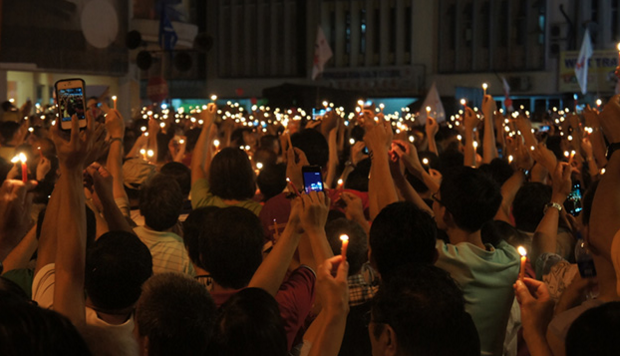
As the crises we face intensify, so does the cry for the Movement of Movements to coalesce into one mass movement for change. But herein lies a seeming paradox: This revolution will not be organized under one umbrella – its diversity is part of its revolution. We are wandering in the woods, looking for the revolution of the Movement of Movements, not seeing the forest for the trees.
The “Movement of Movements” is a phrase used to describe the current profusion of social justice movements sweeping the national and global social-political landscape. Neither an umbrella nor a grand unification organization, it is rather a way of perceiving the threads of connection that link these social justice movements together. The phrase emphasizes the diversity and multiplicity of many groups, organizations, campaigns and individuals, suggesting that the dispersed and varied efforts have a shared thrust to the direction of change we are moving in. The Movement of Movements neither has nor needs a central leadership, coordinating committee, hierarchical command, singular figurehead or slogan. Its strength lies in its complexity, like the numerous ecosystems that create the living biosphere of planet Earth.
This is a breakthrough moment in human consciousness. The capacity to perceive the diverse, dispersed Movement of Movements emerges from a long series of social conditions. It arises from a generation of children taught elementary school ecology. It hinges on the introduction of the word ecosystem into popular vocabulary. It builds off decades of the development of complex and general systems theory that began to pick up steam in the 1970s. It is supported by the millions of Americans who have been studying Buddhist and Taoist philosophies rooted in impermanence and interconnection.
And just in time. Rather than people-power being mobilized like pawns on a chessboard, millions of human beings are co-creating reality together, often without recognizing what they are doing, self-organizing the tremendous thrust of social change required for humanity to make the next evolutionary leap past the looming threat of our extinction into a new epoch of existence.
Social justice activists, spiritual practitioners and scientists alike have long stated that “means are the ends in themaking” … and the way we work for change creates the world that is coming in the wake of the struggle. Within the Movement of Movements, the actions of diverse but interconnected groups create a swarming effect that can address the complex web of issues challenging humanity at this time.
Increasingly, the newsletters, posts and public statements of the movements are saying, “all our issues are connected, the problems arise together, and the solutions relate to one another.” The destructive problems humanity faces arise in an interlocked dynamic of greed, corruption, oligarchy, concentrated wealth, militarization, corporate control, ecological destruction, sexism, racism, violence, hatred and so on. Likewise, the vast and viable solutions to these problems are also interconnected. The means of transformation – our movements – are woven together in a “single garment of destiny,” as Dr. King wrote in Letter from a Birmingham Jail:
“We are caught in an inescapable network of mutuality, tied in a single garment of destiny.”
This is the Movement of Movements, a horizontally connected, multi-nodal phenomenon arising across the national and global social-political-economic-
At present, the Movement of Movements is widespread, diverse and increasingly robust. However, it is largely unaware of itself as a mass movement working on dozens of fronts of the interlocked problems that we face.The multi-nodal movements need to become self-aware. Like Gaia, human consciousness and all awakenings,the Movement of Movements and all its millions of participants, thousands of organizers, hundreds of groups and institutions, need to open their eyes, look around (not just at the navel of their own cause) and recognize ourselves as part of this beautiful, awakening, self-organizing Movement of Movements.
We have been trained in lonely struggle by the same forces that are currently causing worldwide destruction. We were taught isolation, hierarchical control, competitive mindsets and atomization as part of the ongoing global indoctrination of humanity into capitalist-consumer, corporatized, militarized, colonized and conquered, ecocide. We must throw off the shackles of mental slavery, rejecting the concept that our movements are isolated and individualistic.
We stand at the brink of extinction and the only thing that can save us is us. We need an inner, outer and utter revolution. Such a massive shift can occur through the awakening of, and participation in, the emergent Movement of Movements.
Here are a few ways to make the shift:
● Celebrate others’ achievements; the success of one cause is the success of the whole.
● Support each others’ efforts through solidarity, encouragement, resources, media campaigns, etc.
● Take time to analyze the interconnections of the movements. Search for untapped strengths and sources of support. Identify pivot points of change and opportunities for other movements to help sway a critical element of your own movement.
● Talk with each other. Find out how your efforts overlap and look for opportunities for strategic collaboration.
The emergence of the Movement of Movements has arisen out of necessity. The crises shaped the formation of groups, organizations and movements. We are, as yet, mostly unconscious – the proverbial sleeping giant – but now it is time to awaken!














